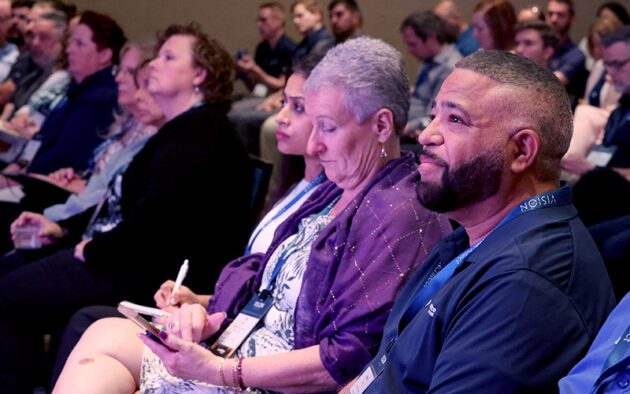Over the past two decades, there has been a meaningful change in the way enterprises engage with their workforce. Advances in workforce time and attendance technology have allowed organisations to gather a wealth of data, highlighting the link between employee well-being and successful business outcomes. With unequivocal proof of a positive relationship between the two, there’s been a collective shift from an input-output approach to thinking about employees holistically to create enhanced employee experiences.
The difference between engaged and unengaged workers is vast, especially for deskless shift workers, who make up over 80% of the workforce. These workers encounter many obstacles that restrict their level of engagement in their roles. Many of these issues centre around ineffective task management, time and attendance tracking, labour forecasting, and poor judgment calls based on limited data. Addressing these issues is a matter of using the right technology.
Global employers today are navigating challenges that are reshaping the way they engage with employees to achieve better operational efficiency and enhance customer experience. As the landscape of workforce management continues to evolve rapidly, organisations are using transformative solutions to redefine their employee engagement strategies.
Enhance Autonomy with Technology
In recent years, the workforce management sector has experienced an unprecedented rate of change, compelling employers to rethink their traditional approaches to employee engagement. This shift has been driven by advancements in workforce time and attendance tracking technology, enabling organisations to unlock the power of data in understanding the critical link between employee well-being and operational effectiveness.
The use of industry-relevant time and attendance software brings numerous employee benefits with it, including the following:
Improved Safety
Time tracking technology ensures sufficient time is provided to complete a job and avoids rushed work that can lead to lapses in focus which could put a worker in harm’s way. Worker rosters optimized through intelligent workforce time and attendance technology can better allocate time for each task. Additionally, workers can easily use such technology to monitor the time it takes to typically complete a task and compare this with their allocation to see whether it is practical.
Enhanced Communication
Workforce time and attendance tracking technology that integrates centralized communication channels saves the company time and eliminates errors. Being able to communicate via a mobile-friendly interface and transcend company silos by talking and developing relationships with colleagues at various levels of the company can help deskless workers to quickly get the information they need to complete a task effectively. This places less of a communication burden on management’s shoulders and gives more autonomy to the worker.
Flexible Rostering
Optimized time tracking technology gives managers and workers more flexibility in shift rostering. It can quickly sift through data on all worker shifts and present it in easy-to-digest visuals, making it simple for managers to swap shifts and see whether worker shift requests are feasible.
For many employees, being able to see an organised overview of their co-worker’s shifts on a centralized platform can help them organise shift changes without being completely dependent on their managers, empowering workers to take more initiative in vocalizing their needs for shift flexibility.
However, based on the Third Annual Global Employee Experience Study, 31% of employees polled reported that their employers did not offer flexible rostering. This suggests organisations may not have the right technology to support it. But as employers are looking for new ways to stay competitive in the market and recruit and retain great employees, investing in the right time management system may support better engagement with employees.
Engaged Workers
Leaders at the forefront of highly productive retail and manufacturing giants aren’t afraid to explore how they can integrate workforce management solutions across all operations.
Such leaders quickly rectify any missed opportunities to engage deskless shift workers and are mindful of choosing a workforce time and attendance solution that’s designed for multi-generational use.
When selecting a time and attendance solution that will be more engaging and likely to produce productive outcomes, ask the following about the technology:
- Does it use mobile-centric software to ensure information about training, roster adjustments, pay sheets, and knowledge resources is easily at workers’ fingertips
- Does it encourage effortless communication through organisational hierarchies, sharing information across ranks and between co-workers
- Does it enable greater independence with self-performance monitoring and self-training tools
- Does it help leaders keep their teams in the loop, with minimal delays or physical barriers
- Does it foster a collaborative culture inside and outside of the production environment
Streamlined Communication
In the life of deskless workers, there are constant changes in procedures, protocols, and compliance. These changes should be communicated directly and transparently from leadership.
Traditional, tiered communication structures facilitate the flow of information from the top leadership down to the front-line workers. Without a fluid communication option for employees to voice questions or feedback, any breakdown in the tiered network communication model can have a severe impact on the business and on employee engagement.
Workforce management software that gives all workers a voice is key to enhancing employee experiences and making employees feel valued and appreciated. Mobile-optimized solutions for time and attendance tracking can be integrated with communication channels to help top-down, bottom-up, and worker-to-worker communication.
Any message sent from leadership needs to be consistent, so the entire organisation, regardless of their location or their shift, receives the same message. Technology can support such high-level engagement, so decision-makers can share information through diverse formats such as videos, slideshow presentations, or knowledge quizzes.
Employee Well-Being
The value of a balanced work and personal life cannot be overlooked when it comes to keeping employees in their best mental and physical state. Employees who feel valued and aren’t overworked have fewer days of unplanned leave and are more likely to feel a sense of loyalty to their employer.
A growing body of research supports the notion that engaged employees are more productive, creative, and committed to their work. By implementing comprehensive workforce management solutions, businesses can cultivate a culture of engagement that promotes employee satisfaction and fosters a positive work environment.
In today’s competitive business landscape, organisations that prioritise employee engagement and well-being are better positioned to drive growth, enhance customer satisfaction, and establish a strong employer brand. By embracing innovative technologies and data-driven approaches, companies can unlock the full potential of their workforce and create a culture of empowerment and collaboration.
WorkForce Software offers a suite of solutions designed to streamline rostering, improve task allocation, and enhance communication across teams. Roster a demo today to see how you can tailor these solutions to optimize your organisation’s operations, reduce inefficiencies, and empower employees to achieve their full potential.




